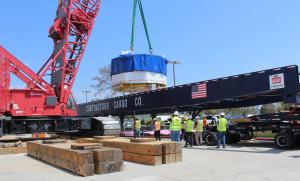Third module on its way
The component that is travelling now is the third of seven modules expected on site. The first, which arrived in September 2021, is currently on a bespoke platform in the Assembly Hall, where the ITER team is performing the requisite assembly steps that must be carried out before the second module is added. These include the creation of specialized electrical connections for the superconducting "leads" that deliver current to the central solenoid modules, as well as inspection and testing.


